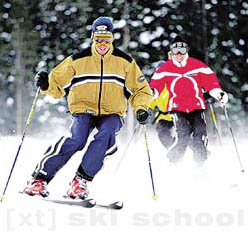|
The Case of Backseat Bill: The intermediate's breakthrough
Last year, Bill showed up for a two hour private lesson. He had skied and taken lessons at Vail, Breckenridge and Snowbird. He commented that he wanted to work on technique and ways to get more control. Bill skied in a slightly crouched position, balancing on his heels while holding his hands by his side except when he planted the pole.
Although his profile is common, the solution lies in balance. Bill had to get his hands in front and start using a wrist movement instead of the arm movement for the pole plant. Run after run he practiced a consistent forward position of the hands. Nonetheless, Bill kept dropping his hands and thus dropping his balance back over the heels of his feet. If he ever wanted to reach that budding expert level of skiing, he would have to master the arm position. After all, it's simple enough, just hold your hands in front with a slight bend in the elbow.
This forward, no bones style of teaching seems to always work. Tell it like it is - no sugar coatings. Bill commented how his lessons in Vail and other ski areas never really amounted to much and nobody ever emphasized the hand position so clearly.
Bill was happy and returned the next two days. By the last day, Bill had mastered the hands and commented on how it seemed to make his skiing more controlled. It's no wonder Bill found the control he had been searching for. The hand position is directly related to where you stand on the skis. If the hands are forward, the front of the boot is pressured, which transfers the pressure to the front of the skis giving the control necessary to steer them into the turn.
The intermediate phase of skiing is the black hole for most skiers, once you reach this point you might not ever get much better. The intermediate skier always has the same mistakes. Most instructors could close their eyes and tell you exactly what the intermediate skier in their lesson needs to work on and be 95% right.
Don't be like most skiers who generally quit taking lessons once they are able to ski most of the runs -- this is a huge mistake. There are so many subtle genres to skiing, it takes a lifetime to master them all on your own. For example, if you want to ski powder, the technique is totally different than groomed run skiing, and if you ski moguls, it's more like powder skiing, but more emphasis is placed on balancing using the pole. The intermediate level is the best time for skiers to take lessons. Professional ski instructors can demonstrate the techniques used for each situation and coach you into the most efficient methods.
Hand position
The position of the arms makes all the difference when it comes to gaining confidence on the slopes. The proper arm position is best taught by focusing on the position of the hands. The hands must be out in front, as if you were carrying a tray of food. The closer you can keep your hands in this position the more balance and control you will find. If the hands are dropped to a position where you could touch your thigh, the weight and balance point of the body will be shifted back off the ball of the foot to the heel, and thus, turning control is lost as the pressure is taken off the front of the ski and steering is lost.
Hand position becomes closely linked to balance as the gradient of the terrain steepens. A forward stance in the steeps is crucial for maintaining control, The front of the ski needs to pressured in order to turn quickly from side to side. If your weight gets shifted to the heel, you will not be able to turn the ski fast enough, and uncontrollable speed will be the result. This is a basic concept, but crucial. If you don't keep your hands up, you will never be a very competent skier.
Alpine Skiing School section in english version of WWW.SKI.BG is based on
"A Guide To Becoming An Expert: From First Time To A Lifetime"
by John Mukavitz Copyright © 1998

|


